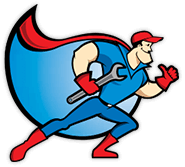A Comprehensive Guide to Your Sewer Line
Your sewer line is the backbone of your home plumbing system. This major pipeline carries wastewater from your showers, sinks, toilets, and appliances out under your property and into the nearby sewer. Chances are, you most likely inherited a sewer line from the old homeowners, so it can be hard to get to know your current system without some investigating.
Most lines are built to last between 50 and 100 years, which means many homeowners are coming up on the date to replace or repair their line.
In this guide, we’ll help you determine when your sewer line was built, the materials used to construct it, and common issues homeowners face with the system. You can also peruse our sewer line checklist to determine if it’s time to have your sewer line looked at by a professional.
What is Your Sewer Line Made Of?
Depending on when your home was built—and the last time your sewer line was repaired or replaced—your sewer line could be made from several materials. Over the past hundred years, different materials when in and out of fashion, and each comes with their own strengths and weaknesses.
- If your home was built between 1860 and 1970: Then your sewer line is most likely made of clay or a material known as Orangeburg, a combination of pitch and wood pulp. There is a strong chance these pipes have already been replaced by previous homeowners since they only have life expectancies of between 30 and 50 years.
- If your home was built after 1980: Your sewer and drain lines were most likely constructed with PVC, a much stronger material that typically only needs to be replaced every 100 years.
If your home was built in between these timeframes, it could go either way. An ARS / Rescue Rooter sewer specialist can help you determine the materials of your pipes, especially if you’re concerned about a problem with your system.
Most Common Sewer Line Problems
Your sewer line reaches underneath the soil of your home and can face a lot of disruption throughout its lifetime. Some of the most common enemies to sewer line health include:
- The weight of the soil and materials above the pipe (such as new construction, concrete, or traffic.)
- Tree roots that slowly extend into or around your pipes
- A shifting ground from an earthquake or severe storm that causes erosion
- Clogs and backflow of water from debris from garbage, soap, food debris, personal products, grease, and fat.
- Damaging cleaning chemicals used over time
When any of these issues become too much for the pipe, you could end up with a break in your line or a clog that sends water back up into your home’s plumbing, a problem known as backflow. In extreme cases, the drain could collapse or breakdown, sending water into your lawn.
Signs of Sewer Line Damage
Without an obvious sign of trouble with your sewer line—such as water flooding your lawn—how do you know you have a sewer line blockage? Sewer line problems are often more exacerbated versions of your common plumbing symptoms. For example, you may experience constant clogs in your drains without a clear cause.
Or, perhaps you frequently hear gurgling sounds coming from your drains or air bubbles backing up through your toilet. Your drains may generally be slow to drain or produce dark and foul-smelling water.
If you detect that your sewer line could be at the heart of your plumbing issues, give our sewer line repair team a call today. We can use rooter techniques such as fiber-optic cameras to find the exact location of your sewer line break or clog. Additionally, the use of trenchless sewer line repair means that we can forego the traditional excavation in your lawn. Our modern tools can remove and replace the old pipe with minimal disturbance to your property.
Looking for HVAC services from ARS Rescue Rooter? Find a technician near you:


